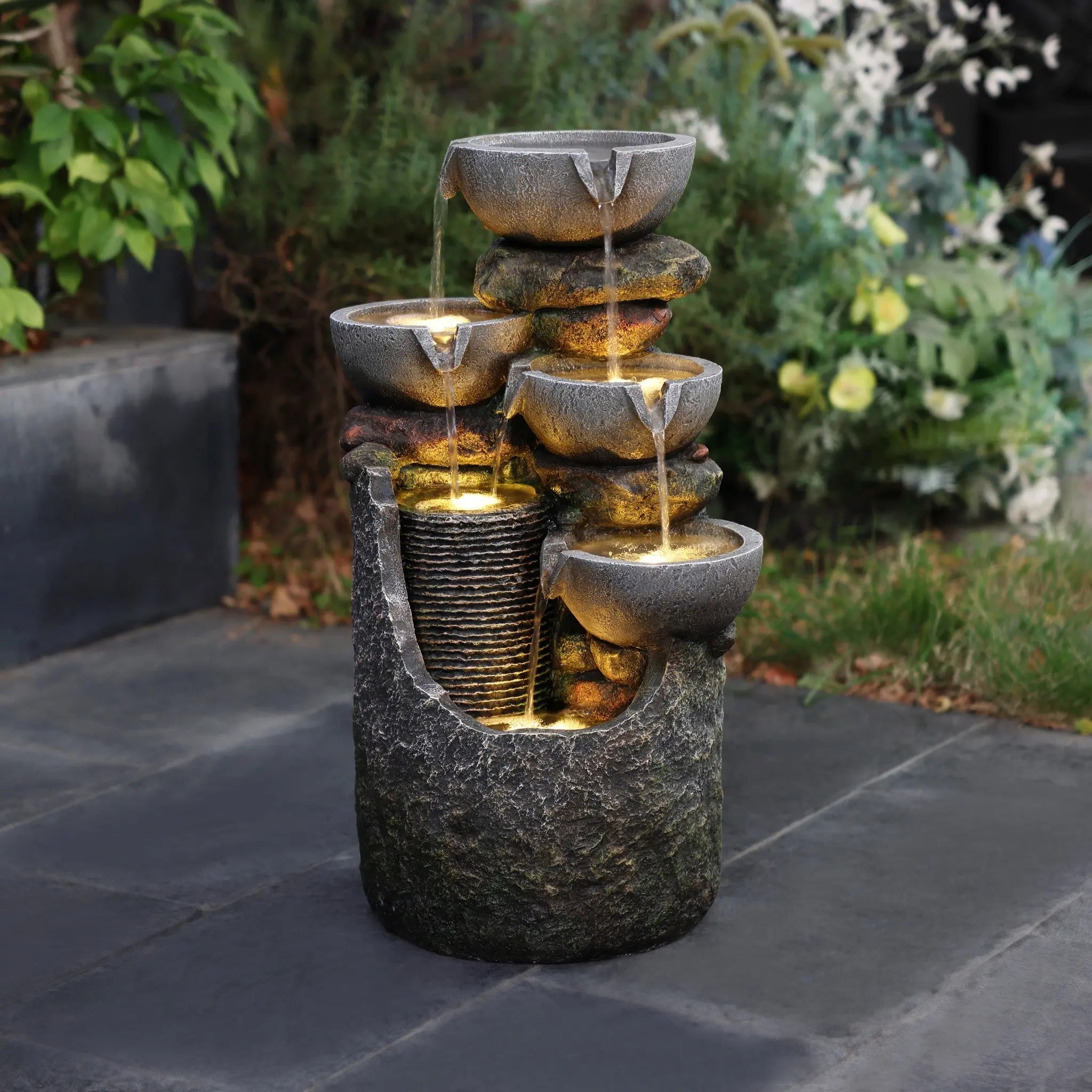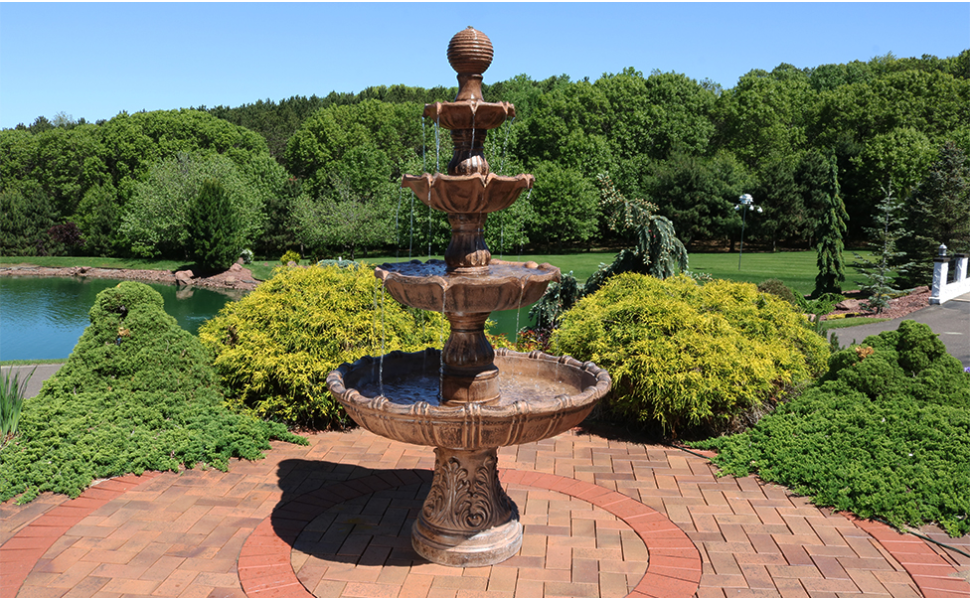A waterfall fountain is a self-contained water feature in which a recirculating pump lifts water to the top of the structure so it can spill over a ledge or series of steps, mimicking a natural cascade. The gentle splashing of a waterfall fountain can transform any outdoor space, imbuing it with tranquility and elegance. Whether you're looking to enhance the serenity of your home garden or create a centerpiece for your business's outdoor area, the placement of your fountain goes a long way in helping you achieve your desired effect. Here, we'll walk you through some top outdoor waterfall fountain placement tips that’ll help harmonize your fountain with its surroundings.
1. Picking a fountain style that fits your space
Selecting the right fountain style for your space requires a balance of aesthetics, functionality, and environmental harmony.
Classic multi-level fountains, like Winsome House Inc.’s sandstone series or the grande tiered pieces featured by Outdoor Fountain Pros, channel European-courtyard elegance and produce a gentle, even splash that won’t overwhelm conversation.

If your deck leans minimalist, think sheet-fall or corten-steel water walls. Their razor-straight weirs send water in a seamless curtain that whispers rather than roars, a chic look against stucco or Ipe siding. Corten’s weather-proof patina evolves from orange to deep umber, masking dirt while adding living color that designers love in industrial, desert-modern, or Zen gardens.
For a wilder vibe, choose hand-carved granite or faux-stone boulder cascades that disappear into planting beds and mimic a woodland creek, the quintessential garden waterfall fountain look.
2. Work with the natural flow of your landscape
Consider the layout of your outdoor space and identify the natural flow of any present natural elements, such as trees, rocks, and grass. A fountain can act as a focal point that draws the eye, but it should also feel like a part of the landscape rather than a jarring addition.
Place your outdoor fountain in an area that benefits from a touch of water and movement. If your space features slopes, a cascading effect along them will increase the beauty and natural charm of the area. For still, flat terrains, create a sense of movement by positioning your fountain between carefully placed boulders. This will further draw the eye and increase the impact that the feature has on the area’s ambiance.
2. Ensure visibility and accessibility
Visibility is key. Position your outdoor fountain where it’s framed by high-traffic windows, transforming kitchen chores into moments of zen as sunlight dances on cascading water. So, it’s also important that your fountain remains visible from the areas you frequent. This visibility is not only for aesthetic purposes but also for maximizing its influence over the environment as a whole.Additionally, ensure the fountain is accessible for maintenance. Cleaning and servicing the pump will be part of its ongoing upkeep, so choose a spot that won’t require extra effort to reach. Remember to leave a clear path around the fountain for easy access, and consider adding a stone pathway for a touch of elegance.
3. Plan for illumination to extend ambiance at night
Another top outdoor waterfall fountain placement tip to keep in mind is to consider your lighting. Outdoor lighting can dramatically change the ambiance and use of your waterfall fountain. Well-placed lights can create spectacular effects at night, accentuating the play of water and casting beautiful shadows around the area. Because of this, consider placing your fountain in a space that you can easily outfit with the proper illumination.
Consider solar-powered lights and strategically place them to avoid glare and enhance the outdoor fountain's features without overpowering them. Dimmer switches or smart lighting technologies can also provide flexibility in controlling the fountain's nighttime presence.

4. Balance noise levels of outdoor space
The sound of water is one of the most enjoyable aspects of a outdoor fountain, but it's important to balance its volume with the surrounding environment. Listen to the fountain's flow before installation and adjust the pump's settings if necessary.
Certain objects can also block or enhance the sound of your fountain's running water. Therefore, take some time to experiment with different placements and layouts until you find an acoustic arrangement that works for the space. Note that fabrics from outdoor furniture can absorb noise, while sheer surfaces like rocks or trees can enhance it.
5. Plan for power and water access.
A outdoor fountain’s magic lies in its illusion of effortlessness, water seemingly flows from nowhere, and lights glow without visible wires. But behind the scenes, smart utility planning is non-negotiable. Start by mapping your electrical and plumbing needs:
GFCI Outlet Proximity
Position pumps and lighting within 15 ft of a ground-fault circuit interrupter (GFCI) outlet to prevent tripping hazards. For larger setups like multi-tiered outdoor waterfall fountains, consult an electrician to install a dedicated 120V circuit.
Water Source Strategy
Opt for a frost-proof hose bib within reach (ideal for seasonal draining), or bury a PVC water line 12" deep if planning a permanent garden waterfall fountain.
Stealth Wiring
Run cables through Schedule 40 PVC conduits buried 18" deep, or disguise them as “roots” using flexible rock molds. The Getty Center’s fountains master this by threading wires through artificial limestone crevices.
Future-Proofing
Leave a 6" service loop of extra cable near the pump housing; this allows adjustments without trenching your entire yard.
6.Account for prevailing winds
In breezy microclimates, splashing can soak walls or pathways. So keep a outdoor waterfall fountain out of the line of dominant gusts or scale back flow rate to prevent overspray.

Studying your region’s wind patterns: Use a simple weather app or consult local gardening groups to identify dominant wind directions. Position your outdoor waterfall fountain perpendicular to these gusts, or shield it with windbreaks like dense hedges or lattice screens draped with climbing ivy.
For unavoidable windy corridors, opt for low-flow designs. Choose tiered “cascade-style” fountains where water clings to textured stone surfaces, minimizing airborne spray.
Test your setup with a garden hose before final installation. Observe how water behaves at different flow rates during peak wind hours. Install a splash guard or apply a hydrophobic sealant to nearby walls.
7. Steer clear of leaf drop, wind, and low spots
A well-sited landscape waterfall fountain needs a clean, stable micro-environment, so keep it well clear of leaf-shedding canopies, blustery wind corridors, and naturally soggy ground.

Seasonal leaf nets work in a pinch, but smart placement is the first defence, especially for lower-maintenance patio waterfalls that rely on compact reservoirs. When deciduous trees shower their foliage in autumn, even a single weekend of leaf fall can choke a pump intake and burn out the motor; installers therefore recommend staying at least 10–15 ft (about 3–4 m) outside the drip line or pruning back overhangs to spare you endless skimming.
Avoid natural low spots that puddle after rain, waterlogged soil undermines the fountain’s footing, invites mosquitoes, and can erode surrounding planting beds; instead, build on a gentle rise or a tamped-gravel pad, and back-fill any depressions with free-draining soil so stormwater flows away rather than flooding the basin.
8.Balance Sun and Shade to Outsmart Algae
Six hours of hard sun may glitter beautifully, but it also fuels algae blooms and faster evaporation. Partial shade or dappled light keeps water cooler and clearer, trimming weekly maintenance in half.

Plant deciduous trees 8-10 ft from your garden waterfall fountain. Their summer canopy blocks 70% of UV rays, while winter bareness allows warmth to inhibit ice. If full sun is unavoidable, plan on more frequent cleanings or add a UV-clarifier.
Never place fountains under evergreens—pine needles acidify water, creating a toxic algae cocktail. Instead, opt for raised basins with overflow drains to flush debris.
9. Observe Feng-Shui flow of outdoor water fountains
If you enjoy energy symbolism, angle the sheet of water toward the house and favor the north (career), east (health), or southeast (prosperity) quadrants rules which also guide where to place a water fountain in the living room. Avoid a south placement, which “clashes” with fire energy.
If you’d like a prosperity boost, orient the outdoor waterfall fountain so water flows toward the house, especially in the southeast, east, or north quadrants.
_0_1200.jpg)
10. Prioritize Safety, Service Access & Wildlife
A outdoor waterfall fountain’s beauty should never compromise safety, functionality, or ecology. By anticipating risks and embracing nature’s rhythms, you create a space that’s both stunning and sustainable.
Begin by envisioning your space through the lens of safety and stewardship. For families with curious children or pets, opt for textured materials like honed bluestone around the fountain’s edge. Consider embedding motion-activated LED lights along pathways; they not only add a magical glow at dusk but gently deter nighttime wanderers from venturing too close to the water’s edge.
When designing access points, think like a future repair technician. Leave a generous three-foot clearance around pumps and filters, disguising service panels under removable faux rocks or hollow garden sculptures. F
True harmony emerges when your fountain becomes a lifeline for local wildlife. Carve gentle pebble beaches into the basin’s edge, creating safe drinking spots for bees and birds while maintaining a slope shallow enough to prevent drownings. Swap harsh algaecides for barley straw bundles—these not only suppress unwanted growth but also double as nesting material for songbirds.
Conclusion
With some preparations, you can ensure your outdoor waterfall fountain becomes a cherished feature of your space, providing beauty and a sense of calm for years. LuxenHome is proud to offer a diverse collection of cascading water fountains that are perfect for elevating the ambiance of your garden or office rest areas. These features will complement your property in the best ways, not only appeasing guests but creating something that you'll love to look upon as well.
FAQs
Q1: Where to place a water fountain in a living room for good energy?
A: Use a compact tabletop design against the north wall (career) or southeast corner (wealth) and angle flow inward, classic Feng-Shui practice.
Q2: How far from trees should I install an outdoor waterfall fountain?
A: A minimum distance of 10-15 ft reduces leaf buildup and pump blockages.
Q3. What’s the 50-foot rule I keep hearing about?
A: Pro pond builders often position a patio outdoor waterfall roughly 50 ft from the back door—close enough to enjoy sound, far enough to prevent spray on walls.

Leave a comment